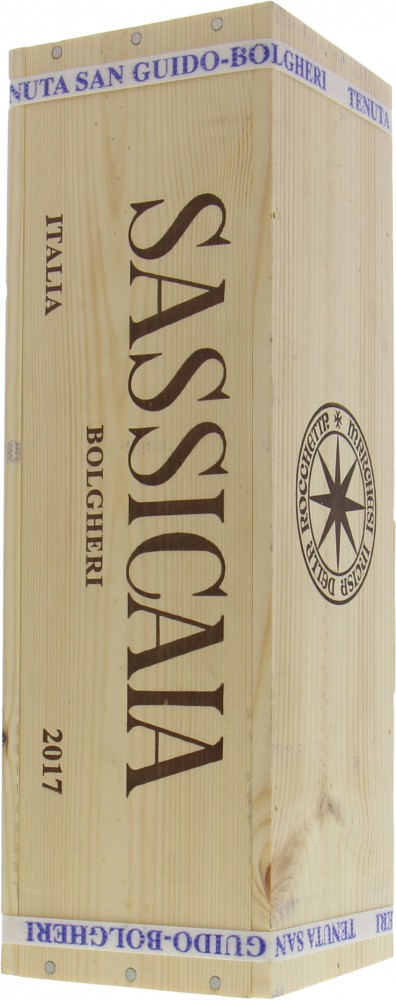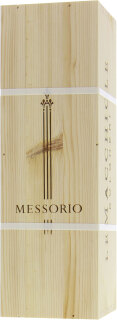Avis professionnels
Robert Parker (94)
The 2017 Sassicaia is a fascinating wine that symbolizes a never-ending tug-of-war between vintner and vintage. The question is who comes out on top? In this case, my money is on the vintner. The 2017 vintage, characterized by scorching heat and drought across much of Italy, was not an easy one. However, vintners had ample time to prepare because those climatic challenges had already played out midway through the summer season. Vintners with experience such as that amassed at Tenuta San Guido (now on the eve of Sassicaia's 50th birthday celebration) knew exactly how to handle the tricky 2017 growing season. Fruit was harvested early to avoid any jammy sensations, and a strict selection process was employed in order to preserve the best clusters. This Sassicaia represents 83% Cabernet Sauvignon and 17% Cabernet Franc, with most of the fruit coming from the Tenuta's historic vineyards Castiglioncello, Quercione and Doccino. These plots are all located on the back hill of Bolgheri at slightly higher elevations where they enjoy cooler nighttime temperatures. Old vines also have a deeper root system that is key to braving dry and hot summers. You can absolutely taste those choices here thanks to the wine's aromatic profile that offers more variety-driven green highlights of wild berry, forest floor and bramble than I would have expected. With time, as the wine takes on more air in the glass, you get a hint of summer plum or cherry cough drop, and this, to my surprise, is the only subtle reminder of the hot vintage encountered. I found the aromas here to be authentically "Tuscan" in character, more so than other vintages, with balsamic and Mediterranean elements that borrow directly from the Sangiovese playbook. I left the wine in my glass over the course of a day, checking back periodically, to find a growing mineral profile of rust or metal that recalls the high concentration of iron and manganese found in these Bolgheri soils. Another vintage-specific adjustment made in 2017 was shorter overall maceration times in steel tanks (from 10 to 12 days for the Cabernet Sauvignon and eight to 10 days for the Cabernet Franc). However, pump-overs and délestages were almost doubled in order to introduce more oxygen to the yeasts during fermentations at lower temperatures. Based on my understanding of fermentation kinetics, this means the 2017 Sassicaia would have achieved the same amount of extraction in about half the time. This process champions the cool-temperature fermentations that are a hallmark of Tenuta San Guido, despite the heat of the vintage. This puts more emphasis on aromatic elegance and minerality, rather than mouthfeel texture or creaminess per se. In fact, the 2017 Sassicaia is much shorter in the mid-palate compared to 2015 or 2016. In terms of oak, Tenuta San Guido takes advantage of the softer tannins found in Allier and Tronçais oak. The 2017 vintage saw a greater percentage (from 20% to 30%) of third and fourth passage barrique during the first 10 months of aging. The decision to use more neutral oak favors the reduction of oxygen and softens the tannic profile. Although the wine does end with a hint of bitterness, it took on noticeably more volume and soft richness the longer I kept my sample in the glass.
Winespectator (95)
A taut, densely wrought red, with black currant, black cherry, iron, wild herb and spice flavors matched to the elegant frame and restrained character. Balanced and long, this has a distinctly Old World feel and looks set to unravel its complex facets slowly. Terrific length. Cabernet Sauvignon and Cabernet Franc.
James Suckling (96)
The balance and beauty to this is impressive, offering sweet, ripe currants and flowers with some crushed-stone and dry-earth undertones. Full-bodied with soft, polished tannins and a long, creamy-textured finish. It’s polished, yet concentrated. Better after 2022, but already very seductive.
Jancis Robinson (17)
I was rather disappointed by the first bottle of this wine I tasted, finding the acidity a bit too intrusive, so decided to open the back-up bottle. This time the wine seemed to have a bit more substance and fruit impact in the middle. The strongest impression created is of balsam and wet stones. It is certainly very unlike any of its fleshier, riper, oakier neighbours. It may well develop more nobility with time in bottle and it already has encouraging persistence, but if you intend to drink it in the first few years of the second decade of the twenty-first century, open and decant it an hour or three ahead and serve it with fairly subtle food. (JR)
Vinous (94)
The 2017 Sassicaia shows the natural richness and intensity of the year while retaining its mid-weight sense of balance and overall poise. A burst of super-ripe red cherry/plum fruit makes a strong opening statement. Mocha, cinnamon, leather and dried herbs appear later, adding aromatic lift. The 2017 is a fairly immediate Sassicaia. Even so, it has enough energy to drink well for a number of years. Production is down 35%, a combination of naturally low yields, dehydration on the vine and then selection in the cellar. Most of the fruit comes from the estate’ hillside vineyards, older parcels that resisted the conditions better.
Decanter (97)
This 2017 Sassicaia is wonderfully fragrant on the nose, but it needs an hour or more to really open up. 2017 was a very difficult vintage mainly because it was so dry it didn't rain for most of the summer and for much of the spring. The vines were stressed, and a lot of fine tuning and management was needed in the vineyards and in the winery to get the best results. But what I love so much about this 2017 is that Carlo Paoli and the Tenuta San Guido team have done a brilliant job. There is a lovely harmony on the palate and a lovely mouth-watering freshness and acidity which is a signature of Sassicaia but more of a challenge in this vintage. There is a little dry twist to the tannins on the finish, but they are beautifully integrated into the rest of the wine and this after all is a signature of the 2017.
BOW (9)
























